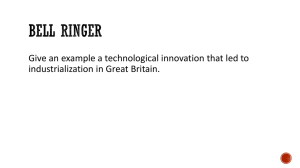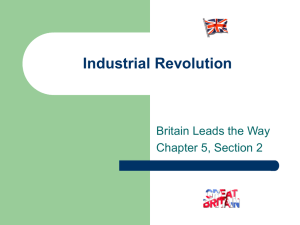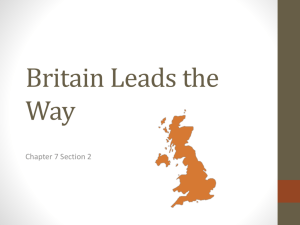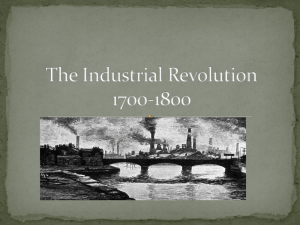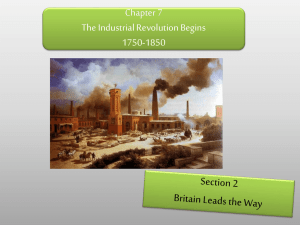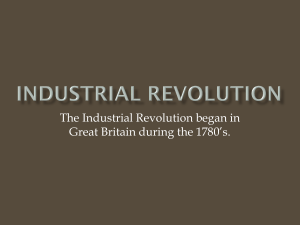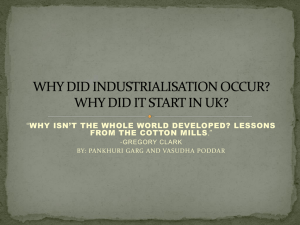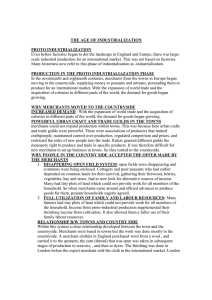The Industrial Revolution
advertisement
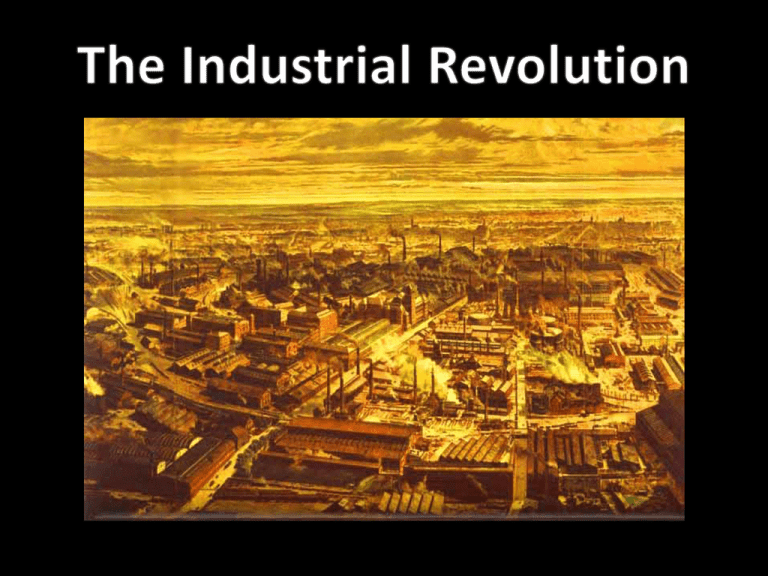
1. The Agricultural Revolution beginning in the 18th century changed agricultural practices. Expansion of farmland, good weather, improved transportation, and new crops such as the potato dramatically increased the food supply. More people could be fed at lower prices with less labor. Now even ordinary British families could use some of their income to buy manufactured goods. 2. With the increased food supply, the population grew. Peasants moved into towns creating a labor supply for factories. 3. Great Britain had a ready supply of money, or capital, to invest in new machines and factories. Entrepreneurs found new business opportunities and new ways to make profits. 4. Natural resources were plentiful in Great Britain. The country’s rivers provided water power for the new factories and a means for transporting raw materials and finished products. Britain also had abundant supplies of coal and iron ore. 5. A supply of markets gave British manufacturers a ready outlet for their goods. Britain had a vast colonial empire, and British ships could transport goods anywhere in the world. A growing demand for cotton goods will increase domestic markets as well. 18th Cottage Industry In the Century, Great Britain had surged far ahead in the production of Inexpensive cotton goods. The manufacture of cotton cloth was a two-step process. First, spinners made cotton thread from raw cotton. Then, weavers wove the cotton thread into cloth on looms. In the 18th C., individuals did these tasks in their rural cottages. This production method was thus called a cottage industry. New Inventions As the demand for cloth grew, inventors came up with a string of remarkable devices that revolutionized the British textile industry. For example, using John Kay’s flying shuttle, weavers worked so fast that they soon outpaced spinners. James Hargreaves solved that problem by producing the spinning jenny in 1764, which spun many threads at the same time. A few years later, Richard Arkwright invented the water frame, which used water power to speed up spinning still further. The new machines doomed the cottage industries. They were too large and expensive to be operated at home. Instead, manufacturers built long sheds to house the machines. At first, they located the sheds near rapidly moving streams, which provided water power to run the machines. Later, machines were powered by steam engines. The Factory System Spinners and weavers came each day to work in these first factories – places that brought together workers and machines to produce large quantities of goods. Early observers were awed at the size and output of these establishments. Early Transportation As production increased, entrepreneurs needed faster and cheaper methods of moving goods from place to place. Some capitalists invested in turnpikes, which were privately built roads that charged a fee to travelers who used them. Others had canals dug to link rivers or connect inland towns with coastal ports. Engineers also built stronger bridges and upgraded harbors to help the expanding overseas trade. Steam Engines The great revolution in transportation was the invention of the steam locomotive. It was this invention that made possible the growth of railroads. In the early 1800s, pioneers like George Stephenson developed steam-powered locomotives to pull carriages along iron rails. The Rocket Locomotive The railroad did not have to follow the course of a river. This meant that tracks could go places rivers did not, allowing factory owners and merchants to ship goods over land. World’s First Rail Line The world’s first major rail line, from Liverpool to Manchester, opened in England in 1830. In the following decades, railroad travel became faster and railroad building boomed. By 1870, rail lines crisscrossed Britain, Europe, and North America.




